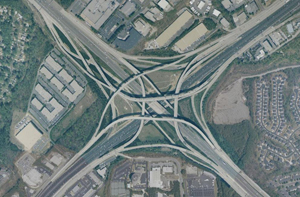Atlanta Interchange Retains Top Spot in ATRI’s Truck Bottleneck Rankings

The five-level stack interchange in metropolitan Atlanta known locally as “Spaghetti Junction” was the nation’s worst truck bottleneck again in 2015, according to a just-released American Transportation Research Institute study.
“Spaghetti Junction” is where Interstate 285 and I-85 North come together and is one of seven Atlanta area bottlenecks in ATRI’s top 100. I-75 at I-285 North joined the top 10 at No. 9, up three spots from last year.
“I’m not surprised in the least,” said Ed Crowell, president of the Georgia Motor Trucking Association. “It’s part and parcel with the reason we supported the fuel-tax increase [that became law] in Georgia in 2015. The bottlenecks that have been noted, ATRI got them exactly right. Our DOT has them on a priority list to work on as the new money flows in from the $1 billion a year we’ve added. There are orange cones everywhere in Georgia.”
Crowell added, “The flip side of having two in the top 10 is because we’re seeing great economic growth in Georgia. However, if we’re still on the list in 2020, I’ll be very disappointed, but I don’t think we will.”
SEE THE FULL TOP 100 LIST: At atri-online.org
“Spaghetti Junction” was joined on the list by the other three locations in last year’s top four: I-95 at state Route 4 in Fort Lee, New Jersey; and I-290 at I-90/94 (known as the Jane Byrne Interchange after the former mayor) in Chicago, which switched spots; and I-65 at I-64/71 in Louisville, Kentucky.
“There is value in seeing certain locations stay on that top 10 because it really does drive home the point that, year after year, these are problematic locations for trucks and for the economy,” ATRI President Rebecca Brewster told Transport Topics. “I like to point to the example of the Jane Byrne interchange in Chicago, which was our No. 1 bottleneck for a number of years [and now is under construction]. With construction comes congestion, [but] ultimately when that redesign is completed — which is supposed to be in 2019 — we would expect to see it move down the list.”
I-71 at I-75 in Cincinnati moved up from No. 7 in 2016 to No. 5, while SR 60 at SR 57 in Los Angeles jumped from No. 9 to No. 6.
I-45 at U.S. 59 in Houston remained at No. 8.
Two other Houston intersections — I-610 at U.S. 290 and I-10 at U.S. 59 — fell out of the top 10. They were replaced by a pair in Washington State: No. 7, SR 18 at SR 167 in Auburn, and No. 10, I-5 at I-90 in Seattle.
“The Puget Sound region has been experiencing phenomenal growth,” explained Sheri Call, executive vice president of Washington Trucking Associations. “Expansion of the roadway capacity has not kept up with the population growth spurred by tech and other industries. Home prices have been skyrocketing, which means people have been commuting further distances for affordable housing.”
ATRI calculates the list from a year’s worth of data, in this case for 2015, of the average speed of trucks through the bottlenecks for a 24-hour period as well as the volume of their truck traffic.
“It’s important for people — the general public, state legislators and the federal government — to understand that while this list highlights traffic problems for the trucking industry, there’s no question that if trucks are moving this slowly at these locations, so are cars,” Brewster said. “These 100 locations are places where trucks are having trouble navigating because of congestion, so everyone’s being impacted.”
Added American Trucking Associations President Chris Spear, “With President Trump expected to press for significant long-term infrastructure spending, this ATRI analysis should be a key guide for deciding what projects are worthy of funding. Ensuring the safe and efficient movement of goods should be a national priority, and this report draws attention to the places where our highway network needs improvement in order to meet that goal.”

